Agnese Purgatorio & Francesco Di Giovanni
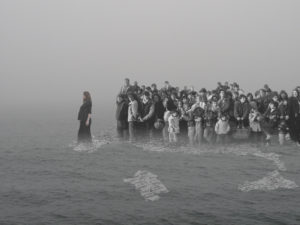 MLB Maria Livia Brunelli Gallery
MLB Maria Livia Brunelli Gallery
Corso Ercole I d’Este 3, Ferrara, Italy
www.mlbgallery.com
in cooperation with
Podbielski Contemporary (Milan)
www.podbielskicontemporary.com
4 October – 16 November 2019
For the double personal exhibition “Mondi Migliori” the MLB Home Gallery and Podbielski Contemporary has selected two artists, who questioned earlier social subjects like exodus and migration. Their works generally don’t strike or choke: it is a sensible approach, which also includes other populations, directly or indirectly. In the current show, they are not focussing on the long insecure getaway, but on the country of destination.
From living clandestine to this side of paradise
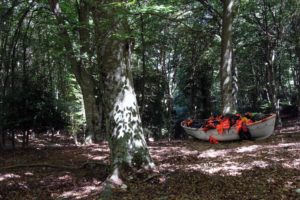 Agnese Purgatorio’s photo collage “Nella clandestinità” (Living clandestine) from 2013 could be read as introduction to her part of the show. Even though it still depicts refugees directly, there is the visionary pregnant woman who seems to lead the migrants into a better future. (“Nella clandestinità” was our artwork of the month/October 2018, read more)
Agnese Purgatorio’s photo collage “Nella clandestinità” (Living clandestine) from 2013 could be read as introduction to her part of the show. Even though it still depicts refugees directly, there is the visionary pregnant woman who seems to lead the migrants into a better future. (“Nella clandestinità” was our artwork of the month/October 2018, read more)
In the photo collages of the new series “This side of paradise”, the people did arrive. The main protagonists in the chosen works are children. Digitally, they are transferred into a forest, probably somewhere in the northern countries as the vegetation indicates. However, the traces of the flight remain visible. One of the images shows a sloping wood with a rescue boat full of life jackets. The scenery remind a bit the stranded Ark of Noah on the Mount Ararat. Hopefully, the journey of the refugees ended on secure ground as in the biblical story.
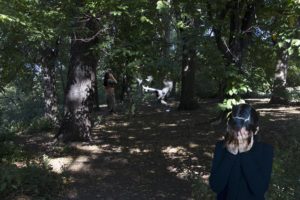 In another picture, the forest appears to be more mystical, since there is a woman, perhaps a shaman, due to her clothes and posture. White doves are fluttering in front of her. In contrast to this magical scene in the background, stands a seemingly crying girl in the foreground. The horror of the experience is not overcome, although the enchantress stands protecting besides. Apparently better, are the two boys in the next image. Relaxed they are wandering through the woods. They are following a path; the one in the front has his eyes closed, perhaps due to another enchantress, which is showing up behind a tree. She is guiding and protecting the boys. Additionally, the front boy wears trousers with the logo of the German football club BVB 09. Maybe this is a sign of arrival and integration.
In another picture, the forest appears to be more mystical, since there is a woman, perhaps a shaman, due to her clothes and posture. White doves are fluttering in front of her. In contrast to this magical scene in the background, stands a seemingly crying girl in the foreground. The horror of the experience is not overcome, although the enchantress stands protecting besides. Apparently better, are the two boys in the next image. Relaxed they are wandering through the woods. They are following a path; the one in the front has his eyes closed, perhaps due to another enchantress, which is showing up behind a tree. She is guiding and protecting the boys. Additionally, the front boy wears trousers with the logo of the German football club BVB 09. Maybe this is a sign of arrival and integration.
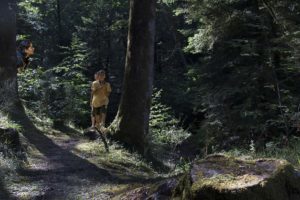 Alike, the girl in the final image seems to have arrived. She is standing in the bushes, but hasn’t found her path yet. On the other hand, her position could be interpreted as rooted, fused with the nature. Moreover, she appears integrated by her climate-adapted clothes and by the composition and colour scheme. The complimentary contrast of green leafs and red jacket highlights her. Therefore, she attracts the attention of the onlooker, although she is standing in the background and not even in the centre of the picture. From her distance, she observes the rotten boat on the left foreground. Due to its position, this ship could be more noticeable, but its muted colour prevents it. Whereas the boat could leave the image immediately, the girl is anchored in the bushes and watches reserved her past passing by.
Alike, the girl in the final image seems to have arrived. She is standing in the bushes, but hasn’t found her path yet. On the other hand, her position could be interpreted as rooted, fused with the nature. Moreover, she appears integrated by her climate-adapted clothes and by the composition and colour scheme. The complimentary contrast of green leafs and red jacket highlights her. Therefore, she attracts the attention of the onlooker, although she is standing in the background and not even in the centre of the picture. From her distance, she observes the rotten boat on the left foreground. Due to its position, this ship could be more noticeable, but its muted colour prevents it. Whereas the boat could leave the image immediately, the girl is anchored in the bushes and watches reserved her past passing by.
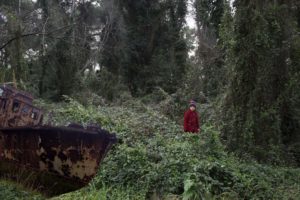 All these photo collages from the series “This side of paradise” have a surreal and magical aspect, by elements, which are not to be expected in a forest, for example the boats. Other details remind fairy tales, in particular the stories collected by the Brothers Grimm. Children in the forest could be found in “Hansel and Gretel”, white doves are helping Cinderella and the “Little Red Riding Hood” get lost in the woods. Moreover, there are witches and fairy godmothers, as we have the protecting and guiding women. These as enchantresses identified persons give the situations a mystical aspect. In reality, they are depictions of Kurdish combatants, an unforeseen coincidence with the recent attacks from Turkey on the Kurdish cities in northern Syria. With a new enemy it will be more difficult for the Kurds to protect against the IS. Overall, the sceneries seem to be taken from a limbo between past and present; even though the anchoring in the new present is more or less suggested.
All these photo collages from the series “This side of paradise” have a surreal and magical aspect, by elements, which are not to be expected in a forest, for example the boats. Other details remind fairy tales, in particular the stories collected by the Brothers Grimm. Children in the forest could be found in “Hansel and Gretel”, white doves are helping Cinderella and the “Little Red Riding Hood” get lost in the woods. Moreover, there are witches and fairy godmothers, as we have the protecting and guiding women. These as enchantresses identified persons give the situations a mystical aspect. In reality, they are depictions of Kurdish combatants, an unforeseen coincidence with the recent attacks from Turkey on the Kurdish cities in northern Syria. With a new enemy it will be more difficult for the Kurds to protect against the IS. Overall, the sceneries seem to be taken from a limbo between past and present; even though the anchoring in the new present is more or less suggested.
A mysterious video
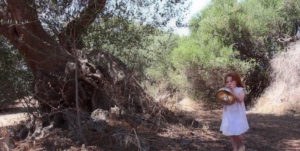 Even more surreal and mystical is the video installation “Cerebrale”. A girl is turning around an olive tree. In doing so, she disappears and appears again and again. It seems to be an ancient mysterious ritual although the girl is relatively young. Her reddish hair remind the medieval imagination of witches, though her white dress points more to a fairy godmother. Surprisingly for an old rite is that the girl is speaking into a megaphone. But in contrast to the young age of the child stands the produced sound: for most people incomprehensible words spoken by adult women. They are the voices of Yazidi woman from the Kurdish part of Iraq and recount their flight from their original region. Although, we cannot understand the stories, the voices are intense as if coming out of the landscape. Intentionally, the artist did not introduce subtitles, to let the observer concentrate to image and sound.
Even more surreal and mystical is the video installation “Cerebrale”. A girl is turning around an olive tree. In doing so, she disappears and appears again and again. It seems to be an ancient mysterious ritual although the girl is relatively young. Her reddish hair remind the medieval imagination of witches, though her white dress points more to a fairy godmother. Surprisingly for an old rite is that the girl is speaking into a megaphone. But in contrast to the young age of the child stands the produced sound: for most people incomprehensible words spoken by adult women. They are the voices of Yazidi woman from the Kurdish part of Iraq and recount their flight from their original region. Although, we cannot understand the stories, the voices are intense as if coming out of the landscape. Intentionally, the artist did not introduce subtitles, to let the observer concentrate to image and sound.
The fragility of life
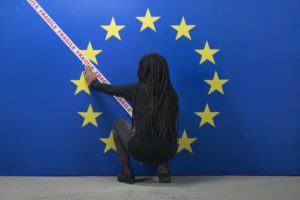 For the second part of the exhibition, Francesco Di Giovanni presents his video installation “The Flag Relocation”. It is the documentation of a by him initiated performance. A girl, Sami, originally from Ethiopia bonds an adhesive tape on a European flag. The yellow stars consecutively disappear, until only one remains visible. This star represents Italy, home giving country for the girl due to adoption. For Sami Italy represents a new life, where she found a new family.
For the second part of the exhibition, Francesco Di Giovanni presents his video installation “The Flag Relocation”. It is the documentation of a by him initiated performance. A girl, Sami, originally from Ethiopia bonds an adhesive tape on a European flag. The yellow stars consecutively disappear, until only one remains visible. This star represents Italy, home giving country for the girl due to adoption. For Sami Italy represents a new life, where she found a new family.
Another aspect of the film is the adhesive, which is labelled with the word “fragile”. This kind of tape is generally used to protect breakable goods during transport. In this context, it might refer to the fact that life in general and especially in an unknown country is still delicate and could be shaken by personal, social or political events. Moreover, in connection to the European flag the tape is the hint to the fragility of this association of states. Once the European integration was symbol for stability, democracy and a common life. By the upheavals of the last decades, the European Union is weakened by divergent concepts of the common values and social and economic crises in and outside the community. Might the adhesive tape help to hold the states together?
Completed is the video, by photos of the performance, which could deliver even more interpretations: Sami in front of the European flag might symbolise her arrival; the tape over her mouth might be a warning not to speak out everything; her uncertain glance to her unfinished work could be seen as unease for the future. There are many more feelings to discover in contemplating these images and might be different depending on the personal situation and the relation to the European Union.







